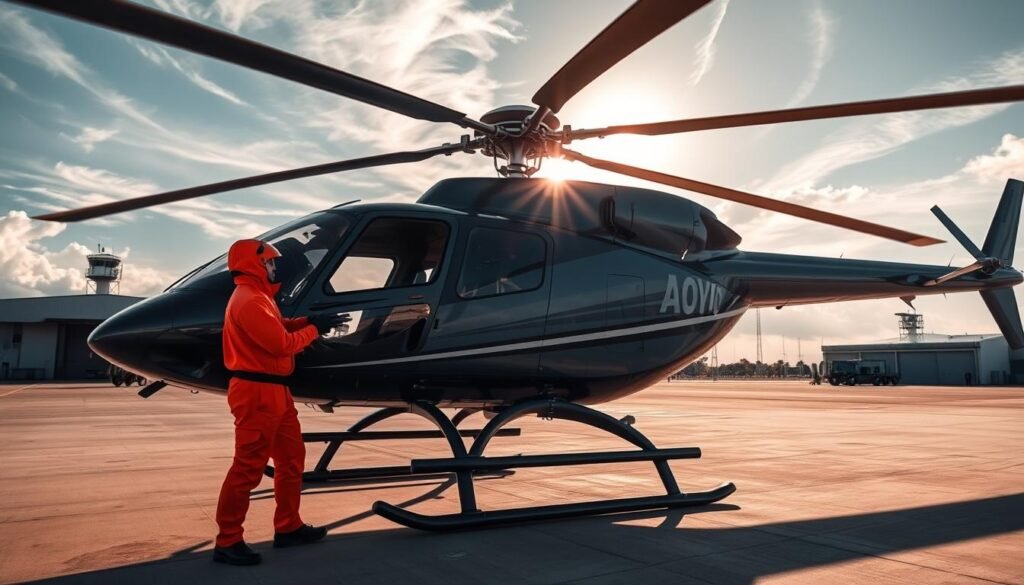Helicopter pilots are trained to handle a wide range of in-flight emergencies. While helicopters are generally safe, unexpected incidents can occur due to mechanical issues, weather changes, or other unforeseen factors. Knowing how to respond quickly and effectively to emergencies can make the difference between a safe landing and a dangerous situation. In this article, we will discuss common in-flight incidents that may occur during helicopter flights and the emergency procedures pilots must follow to handle them safely.
1. Engine Failure: The Autorotation Maneuver
One of the most critical emergencies in helicopter flight is engine failure. In the event of engine failure, the pilot must rely on autorotation—a maneuver that allows the helicopter to descend safely without engine power. During autorotation, the helicopter’s rotors continue to spin, generating enough lift to control the descent and make a safe landing.
Steps for Handling Engine Failure:
- Enter autorotation: Reduce the collective pitch to minimize drag and allow the rotors to maintain speed.
- Monitor rotor RPM: Ensure that rotor RPM remains within the safe operating range during the descent.
- Select a landing site: Choose a flat, clear area to make a controlled emergency landing.
- Flare before landing: Just before touching down, the pilot flares the helicopter by pulling back on the cyclic to slow down the descent and ensure a soft landing.
2. Tail Rotor Failure: Managing Directional Control
Tail rotor failure is another dangerous situation that can occur during helicopter flight. The tail rotor is responsible for counteracting the torque produced by the main rotor, allowing the helicopter to maintain directional control. If the tail rotor fails, the helicopter will start spinning uncontrollably. Pilots must act quickly to regain control and land safely.
Emergency Procedures for Tail Rotor Failure:
- Lower the collective pitch: This reduces the torque and minimizes the helicopter’s spin.
- Enter autorotation (if necessary): If the helicopter is at a high altitude, autorotation can help reduce torque and maintain some control.
- Perform a run-on landing: If there is enough forward speed, a run-on landing (landing while moving forward) can help stabilize the helicopter during the landing.
- Use natural features for control: If possible, use the wind or terrain to help control the helicopter’s direction during descent.
3. Hydraulic Failure: Maintaining Control Without Assistance
Most modern helicopters are equipped with hydraulic systems that assist with flight controls, making them easier to operate. In the event of hydraulic failure, pilots will need to exert much more physical force to control the helicopter, but they can still safely land the aircraft.
Procedures for Hydraulic Failure:
- Recognize the signs: Stiff or unresponsive controls indicate a hydraulic issue.
- Turn off hydraulic boost (if applicable): In some helicopters, the pilot can turn off the hydraulic boost system to prevent further complications.
- Fly smoothly: Avoid sudden movements of the controls, as the helicopter will be more difficult to maneuver.
- Land as soon as practical: Find the nearest suitable landing area and make a controlled descent and landing.
4. Electrical Failure: Dealing with Instrument and Power Loss
Electrical failures can result in the loss of communication systems, navigation instruments, and other critical electrical components. While not immediately life-threatening, it can make navigation and coordination more difficult, especially during bad weather or in controlled airspace.
Handling Electrical Failure:
- Switch to backup power: If the helicopter is equipped with a backup electrical system or battery, activate it immediately.
- Use visual flight rules (VFR): If instruments are lost, revert to visual flight and rely on external cues for navigation.
- Communicate with air traffic control (ATC): Use backup communication systems or visual signals to inform ATC of your situation.
- Land at the nearest airport or suitable location: Prioritize landing safely and reporting the failure once on the ground.
5. Fire in Flight: Immediate Response to Contain the Situation
A fire on board a helicopter is one of the most dangerous in-flight emergencies. Pilots must act immediately to extinguish the fire or minimize its impact. The source of the fire could be electrical, fuel-related, or engine-related, and the pilot’s response will depend on the fire’s location.
Emergency Procedures for In-Flight Fire:
- Turn off affected systems: If the fire is electrical, immediately turn off the affected systems to cut power to the fire’s source.
- Activate fire suppression (if available): Many helicopters are equipped with fire suppression systems that can be activated to extinguish engine or fuel fires.
- Execute an emergency descent: If the fire cannot be extinguished, the pilot should perform an emergency descent to land as quickly as possible.
- Land immediately: Find the nearest safe landing location and evacuate the helicopter once it is on the ground.
6. Severe Weather: Navigating Through Dangerous Conditions
Flying into unexpected severe weather, such as heavy rain, thunderstorms, or strong winds, can be challenging for helicopter pilots. Bad weather can reduce visibility, affect the helicopter’s stability, and make navigation difficult.
Steps for Handling Severe Weather:
- Reduce speed: Slow down the helicopter to reduce the risk of losing control in turbulent conditions.
- Fly at a lower altitude: If safe, flying lower can provide better visibility and less severe turbulence.
- Avoid dangerous areas: If thunderstorms or extreme conditions are ahead, consider diverting to another location or turning back.
- Land if necessary: If the weather becomes too dangerous, land the helicopter at the nearest safe location and wait for conditions to improve.
7. Loss of Power in Hover: Reacting Quickly to Avoid a Hard Landing
Losing power while in a hover can lead to a sudden drop in altitude. Pilots must react quickly to avoid a hard landing or crash. The key is to smoothly transition into autorotation or reduce collective to cushion the descent.
What to Do:
- Lower the collective: This reduces the pitch of the rotor blades, allowing the helicopter to descend smoothly.
- Prepare for autorotation: Be ready to enter autorotation if necessary, especially if hovering at a higher altitude.
- Cushion the landing: As the helicopter descends, use the collective to slow down just before landing to ensure a soft touchdown.
Conclusion
Helicopter pilots are trained to handle a variety of in-flight emergencies, from engine failures to severe weather. By following the proper emergency procedures and maintaining a calm, focused mindset, pilots can navigate through dangerous situations and bring the helicopter and passengers safely to the ground. Preparation, practice, and knowledge of the aircraft’s systems are essential for ensuring a safe outcome during unexpected incidents.
Related Articles
- How to Avoid Common Helicopter Pilot Errors: A Guide to Safe Flying
- The Role of Air Traffic Control in Helicopter Safety
- Helicopter Safety in Bad Weather: Tips for Flying in Adverse Conditions
- How to Safely Land a Helicopter in Challenging Conditions
- The Importance of Proper Helicopter Maintenance for Flight Safety
More from This Category
- Understanding Helicopter Weight and Balance: Why It’s Crucial for Safe Flying
- Emergency Procedures in Helicopter Flights: How to Handle In-Flight Incidents
- Helicopter Pre-Flight Inspections: What Pilots Must Check Before Takeoff
- How to Prepare for Your First Helicopter Ride: Safety Procedures for Passengers
- Top 10 Helicopter Safety Tips Every Pilot Should Know



